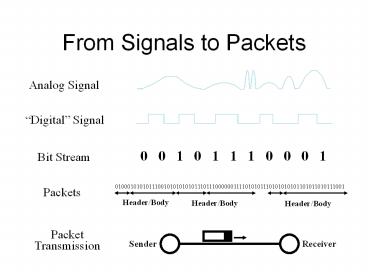From Signals to Packets - PowerPoint PPT Presentation
1 / 7
Title: From Signals to Packets
1
From Signals to Packets
2
Why Do We Care?
- How much bandwidth can I get out of a specific
wire (transmission medium)? - What limits the physical size of the network?
- How can multiple hosts communicate over the same
wire at the same time? - How can I manage bandwidth on a transmission
medium?
3
Signal Sum of Waves
4
Modulation
Amplitude
Frequency
Phase
5
(No Transcript)
6
The Nyquist Limit
- A noiseless channel of width H can at most
transmit a binary signal at a rate 2 x H. - E.g. a 3000 Hz channel can transmit data at a
rate of at most 6000 bits/second - Assumes binary amplitude encoding
7
Capacity of a Noisy Channel
- Cant add infinite symbols - you have to be able
to tell them apart. This is where noise comes
in. - Shannons theorem
- C B x log(1 S/N)
- C maximum capacity (bps)
- B channel bandwidth (Hz)
- S/N signal to noise ratio of the channel
- Often expressed in decibels (db). 10 log(S/N).
- Example
- Local loop bandwidth 3200 Hz
- Typical S/N 1000 (30db)
- What is the upper limit on capacity?
- Modems Teleco internally converts to 56kbit/s
digital signal, which sets a limit on B and the
S/N.

